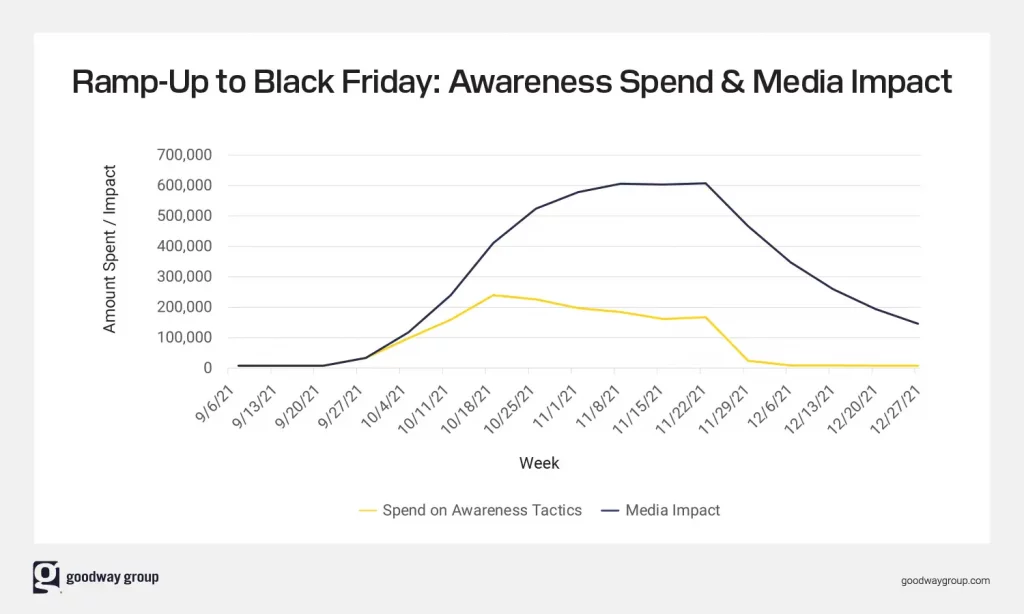Increase Marketing Revenue With a Media Mix Model

CMOs and marketers know they need to adjust their marketing strategy in an economic downturn to make every dollar count. But what they often don’t know is how to do it.
What digital marketing channels and tactics should stay or go? Which ones offer the most ROI? What KPIs should they track to gauge success for their brand to come out the other side even stronger and more successful than before?
There’s no right answer. Annoyingly, it depends. It depends on your audience, your industry, your budget, on so many variables. But what makes digital marketing so effective is it’s measurable. You can dig into client data, look at your results and find the right answer for your brand. And one way you can do that is by using a media mix model. A media mix model helps you look at diminishing returns by channel so you see how to make the most effective and efficient use of the dollars you have.
Leveraging a Media Mix Model To Inform Incremental Revenue
An ecommerce industry client reached out to all their media partners with this question: How can we achieve increased revenue goals for 2022?
After updating their revenue goals at the end of the first half of the year, they projected they would fall short of target revenue by 19%. So they wanted to understand how each partner could help support this goal by adding incremental budgets, adjusting strategy and executing campaigns.
Our team at Goodway decided to take it to the next level and look for answers within the client data. We implemented a media mix model using historical data to understand the impact of media buying on each tactic to determine where the next marketing dollar should go.
What we found challenged our intuition. But it ultimately proved right once we understood the multiple interacting aspects of user behavior in the buying funnel. Here are three major insights we uncovered using a media mix model to help inform how you spend your marketing dollars.
1) Invest in Awareness for Long-Term ROAS.
The law of diminishing returns holds that each additional unit of advertising investment increases the return, but at a declining rate. That is, a process that exhibits a diminishing return (and in our case channel spend) will have an optimal level of investment beyond which additional investment has minimal return.
In a media mix model, we take spend on each marketing channel and fit a diminishing return curve. For example, the figure below has diminishing return curves for two marketing channels for two brands.

Figure 1: Diminishing return curves for two channels for two brands. For Brand A Prospecting + Retargeting, the point of diminishing returns is ~$300k spend per week. For Brand B Prospecting + Retargeting, the point of diminishing returns is at $100k spend per week. For awareness channels, the point of diminishing returns is lower for both brands.
Our initial diminishing return curves for prospecting and retargeting were consistent with expectations. With only minor adjustments to the weekly budgets (+/- 5%), we could maximize the brand’s ROI. Hurray!
However, the diminishing return curves for the awareness channels were far below intuition. After some deeper analysis, we found it was because awareness campaigns have an impact over a longer time, three weeks in this case, and so showed misleading results on ROAS. (Eliminating awareness spend immediately increases ROAS, but only in the short term.) In a revised media mix model, we accounted for the longer impact of awareness campaigns and concluded we should reduce spend in prospecting and retargeting tactics to increase spending on awareness. The result of the new strategy was increased ROAS over the modeling period, not just the short-term daily ROAS.
2) Learn Each Channel's Mathematical Optimum.
Using the diminishing return curves for each tactic, we calculated (and show in the figure below) the incremental revenue (yellow bars) and ROAS (black dots) for varying levels of incremental spend. Consistent with the theory of diminishing returns, the revenue and ROAS increase until it hits a peak at $240k per week. After this point, the return on ad spend starts to decrease with additional investment. We used this as the recommended budget for Q3 2022 with $1.2MM projected in incremental return.

Figure 2: Incremental revenue and ROAS as a function of incremental spend calculated from the fitted diminishing return curves generated by the mixed media model.
3) Time the Market To Maximize ROAS.
Many ecommerce companies take advantage of the holiday season to increase returns by boosting media budgets ahead of major holidays like Black Friday. Generating awareness, increase in reach and competition in the market are crucial considerations for holiday strategy planning. Awareness efforts, the main tactics used during the pre-holiday period, usually have a higher adstock effect than lower funnel tactics. In other words, the effect of awareness advertising is not often immediate on consumer purchase behavior. Optimizing revenue means finding the right timing for awareness tactics so the peak media impact occurs when consumers are most likely to purchase.

Figure 3: Raw media spend and adstocked media spend for awareness tactics leading up to Black Friday.
Using data from the 2021 holiday season, we quantified the lag between awareness spending and its impact on the market. Awareness spends in 2021 (represented by the yellow line) started ramping up 60 days in advance of Black Friday. As spending increased, the adstocked media (or media impact) accumulated to a peak right before sales started. However, if spending had remained at elevated levels for a couple of additional weeks, the peak media impact would have included the Black Friday holiday. As it was run, awareness began to fall during the sale. The 2022 recommendation was to start two months in advance with a peak spend four weeks ahead of Black Friday to maximize the impact of awareness spend.
Conclusion
A media mix model takes a holistic approach to understanding the relationship between marketing spend and KPIs. As the world becomes more privacy-centric and more data is enclosed within walled gardens, data-driven marketing techniques such as this are becoming increasingly important to maximize ROAS.
If you want to uncover insights you can use to make your marketing strategy stronger and your marketing dollars work harder at driving revenue and growth – we’re standing by.





